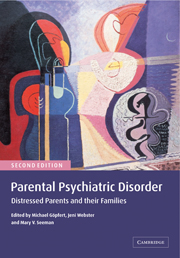Book contents
- Frontmatter
- Contents
- List of contributors
- Foreword
- Preface
- Part I Basic issues
- 1 What we want from adult psychiatrists and their colleagues: ‘Telling it like it is’
- 2 Parenthood and adult mental health
- 3 Parental psychiatric disorder and the developing child
- 4 Parental psychiatric disorder and the attachment relationship
- 5 The construction of parenting and its context
- Part II Comprehensive assessment and treatment
- Part III Specific disorders: the impact on parent–child relationships
- Part IV Specific treatments and service needs
- Part V Child-sensitive therapeutic interventions
- Part VI Models for collaborative services and staff training
- Afterword
- Index
- References
5 - The construction of parenting and its context
from Part I - Basic issues
Published online by Cambridge University Press: 09 August 2009
- Frontmatter
- Contents
- List of contributors
- Foreword
- Preface
- Part I Basic issues
- 1 What we want from adult psychiatrists and their colleagues: ‘Telling it like it is’
- 2 Parenthood and adult mental health
- 3 Parental psychiatric disorder and the developing child
- 4 Parental psychiatric disorder and the attachment relationship
- 5 The construction of parenting and its context
- Part II Comprehensive assessment and treatment
- Part III Specific disorders: the impact on parent–child relationships
- Part IV Specific treatments and service needs
- Part V Child-sensitive therapeutic interventions
- Part VI Models for collaborative services and staff training
- Afterword
- Index
- References
Summary
Introduction
This chapter aims to clarify the term ‘parenting’ as a social role within a culturally determined social construction. It will provide tools for the formulation of parenting and for the understanding of the complex interface between psychiatric disorder and parenting in the context of mental health services and of family/community. This will establish the ground against which the gestalt of the professional task of performing a parenting assessment is considered (see Göpfert et al., Chapter 7) and against which some of the effects of parental psychiatric disorder on children can be understood.
The chapter will use the role-relationship paradigm (Horowitz et al., 1995; Muran, 2002; Nye, 1976; Nye & Berardo, 1981; Ryle & Kerr, 2002) as a framework for understanding parenting across the spectrum of care. The role-relationship model facilitates an understanding of both the internal/personal and the social aspects of the parenting role, their interface with one another and with the role of the helping professional. Early role experiences are internalized and form the backbone of personality development. This construct overlaps with the concept of internal working models that comes from attachment theory (see Adshead et al., Chapter 15). Roles and role relationships are useful for understanding the interface between a social role, such as parenting, and the personality of the person enacting the role. Services are not currently designed to deal with such complexity and tend to provide a service that either addresses parenting problems or mental illness problems.
Keywords
- Type
- Chapter
- Information
- Parental Psychiatric DisorderDistressed Parents and their Families, pp. 62 - 84Publisher: Cambridge University PressPrint publication year: 2004
References
- 4
- Cited by

